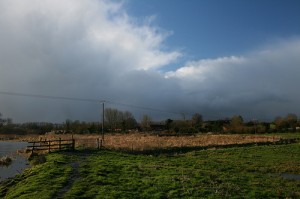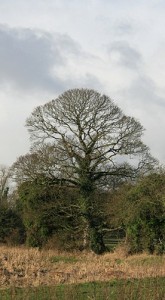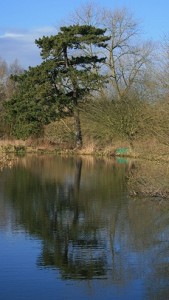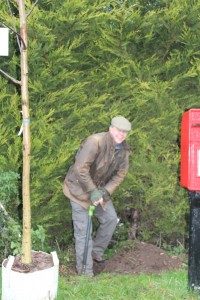
A few sharp frosts in recent days have nipped the leaves off the Sycamore and the Ash trees, but the Oak leaves have just turned a rich burnished bronze. This one, on the south side of Keeper’s Wood gently glows in the morning sunlight.

A few sharp frosts in recent days have nipped the leaves off the Sycamore and the Ash trees, but the Oak leaves have just turned a rich burnished bronze. This one, on the south side of Keeper’s Wood gently glows in the morning sunlight.
Early December and the first real frost of the month. The grass on the Long Meadow white and brittle. A Kingfisher whirred away downstream in front of us along the Mermaid and, not finding a nearby wide ditch to it’s liking, it doubled back towards us calling loudly and flew up and over the railway embankment in search of quieter reaches. At this time of the year the rich orange breast of the bird glowed in contrast to the dazzling blue of its back.
All trees except the Oaks have lost their leaves. Around the Field Maples there are pools of yellow leaf-carpets. The Poplars have changed their note in the breeze, now the branches emit a low moan and no longer the sibilant whisper of the leafy early autumn. Strangely, some of the Oak leaves are still quite green and have yet to succumb to the ochre and orange of the discard.
The finches, mostly Linnets and goldfinches, have gathered in flocks along the ditch side Alders. Their contact calls drift on the breeze.
Now the breeze is northerly. The branches sway at the change in direction and Birch leaves rain gently down on the garden with every gust. The village lanes are strewn with the leaves of Sycamore. Hazel and Wych Elm. The Field Maples, which have taken on a glowing chrome yellow, are slowly losing their fight to keep their leaves. On the railway line the Poplars are already bare, their wind note has changed in pitch and the sweet smell of leaf decay scents the air.
As I stack wood – the most Autumnal of tasks – a ragged skein of geese head towards the coast; at least one hundred strong. I watch and listen for a minute or two. The cut logs give off their scent of sap and resin. Indoors, the plaintive notes of French Horn from a Britten Pastoral adds to the Autumnal feel.

A giant fell this morning. The skeletal carcass of the last English Elm to have reached maturity in the village has been brought crashing to ground. It had far outlasted its contemporaries – many of which were felled when the Dutch Elm Disease struck in the 1970’s – but now decay had finally so-weakened the stem that it was unlikely to remain standing for a further winter. So, at ten minutes to ten on a Sunday morning, following a short chainsaw cut and a haul on a tractor winch, the old tree cracked and came to earth. What was left of its crown, which once touched up to 100 feet in height, split in to many pieces on impact. Tell tale star-like shadows of fungal growth showed through where the viable bark had spilt away. These are the marks of its death and decay. The stump looks as weak as cork. There is a gap in the skyline. Some ten years ago tree surgeons had taken cuttings from its then fully leaved crown in the hope that it was disease resistant. But the cuttings came to nothing and the disease took hold. Now this is its epitaph.
It’s young relations, mostly clones of the parent, still sporadically grow as hedge plants for a few years until the Dutch Elm gets to them. No Elm in the parish reached maturity in recent years. The bare branches remain in hedge lines for a few years until they are tidied away or trimmed back. The Elm is no longer a feature in the local landscape. Although it held on for longer than most in the area.

Hail from a passing squall stung our faces as we walked upstream from Oxnead. A reminder that we cannot take the arrival of the weak Spring sunshine for granted. As we pressed on the clouds moved southwards and the sun light broke through and created a dramatic contrast. Colour leaped from the highlighted trees and the shapes of their bare winter crowns gained new depth. Around the village  the variety of trees gives texture to the landscape. a sycamore, so often
the variety of trees gives texture to the landscape. a sycamore, so often damned as a species, shows as a beautiful dome marking the edge of the ploughed lands and the start of the marsh. A Scots Pine sits over a gentle curve of the Bure, its reflection set with the pristine clarity of a Japanese print. Below the Hall Beech, Oak and the spiralling bark of the Chestnut provide an arboretum’s grandeur.
damned as a species, shows as a beautiful dome marking the edge of the ploughed lands and the start of the marsh. A Scots Pine sits over a gentle curve of the Bure, its reflection set with the pristine clarity of a Japanese print. Below the Hall Beech, Oak and the spiralling bark of the Chestnut provide an arboretum’s grandeur.
The Parish Council has just planted a Walnut Tree near the bus shelter. This tree was given to the parish by the Conservation Team at Broadland District Council and has been planted to commemorate the Queen’s Diamond Jubilee

The slow death of a 100 year old Ash tree in the village is surely due to the currently rampant Chalara fraxinas infection – although this has yet to be proven. I have been watching it’s slow decline over the last two years or so, initially just the tips of the branches, but last year the dieback was noticeably dominant. The tree, in some firm of emergency measure, sprouted secondary “epicormic” growth from the larger branches, but this summer even those have failed. By the autumn the few leaves it could produce were on lower branches which had sprung from the root or thereabouts. By this autumn these leaves were withering in the manner shown on the Forestry Commission’s identification sheets. I now wait for the Forestry Commission to asses the tree properly.
I do not think that this is the only tree infected – there is another mature specimen showing similar symptoms, but not as advanced. It is a concern of course that a number of the others in the parish are already infected. This is highly likely. The real question t ask is whether any will have a much-hoped for resistance. The landscape is certainly going to change.
In spite of the raw cold which seems to have dominated the past week, the occasional warm spring sunshine has encouraged some activity from trees.
So far, some the Hawthorns along the railway line have tentatively started to open as has the Bird cherry outside Beech Cottage. But then, like someone who has dipped their toe into a cold swimming pool they have stopped. They seem to be pausing and are prepared to wait for the next warm day. This point of near bud-burst always reminds me of that Philip Larkin poem, the Trees; “The trees are coming into leaf, like something almost being said”.
Most of the trees are far more cautious. No hint of green, just that almost imperceptible thickening at the tips of the branches. I swear I can see this subtle transformation through my window as I look out at the Sycamores and Ashs on the railway line, but this may be just wishful thinking.